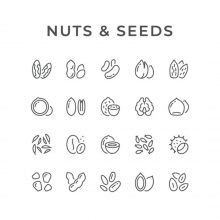The Definitive Guide to Nuts and Seeds

Maybe nuts and seeds have been on my mind because of my last post about fiber. Or perhaps it’s because I have a client who thought that she hated walnuts until she roasted them.
While I do love raw nuts and seeds and use them liberally in everything from my morning buckwheat cereal to smoothies to salads to sprinkling them on soups, roasting and toasting really brings out their delicious, earthy flavor.
I also love the amazing crunch and texture they provide—they truly add a new dimension to any dish. If, like me, you love chips but you’re looking to up your nutritional game, many get the same satisfaction from nuts and seeds (salted, of course!) as they do their beloved chips.
We can’t talk about nuts and seeds without highlighting their butters. Talk about flavor! While peanut butter (peanuts are technically a legume) is a favorite for many, the butters of some seeds and other nuts are divine and I’d put many of them in the dessert category!
Instead of recreating the wheel and republishing our guide to these nutritional nuggets in this blog post, I’ve created a PDF document excerpted from our Essential Thyroid Cookbook that’s the definitive guide for nuts and seeds. It’s from Part Two: Essential Thyroid Kitchen, the Pantry Staples and Ingredients section, and below is Lisa, my co-author’s intro to that chapter.
You’ll learn all about the following, including their nutritional benefits:
Almonds
Brazil nuts
Cashews
Chia seeds
Coconut flakes (As Lisa says, “Botanically speaking, coconut is a drupe, not a nut, and is therefore safe for most people with tree nut allergies. It shares many similar characteristics to nuts and seeds—it can be soaked and blended into homemade plant-based milk or sprinkled on hot cereal, smoothies, and desserts.”)
Flaxseeds
Hazelnuts
Hemp seeds
Macadamia nuts
Pecans
Pistachios
Pumpkin seeds (pepitas)
Sesame seeds (including tahini)
Sunflower seeds
Walnuts
…including how to soak nuts and seeds for optimal digestibility and how to toast them for flavor enhancement. You’ll want to pay attention to temperature!
As Lisa says, “Nuts and seeds provide a healthful combination of essential fats, protein, and fiber all contained in a nutrient-dense package. They can be enjoyed in their whole form, as a flavorful nut or seed butter, or in some cases, used in their flour form for baked goods.
“Individually, nuts and seeds vary in key nutrients. To obtain a broad spectrum of essential nutrients, be sure to eat a variety of nuts, seeds, or nut butters in their raw, soaked, or gently toasted forms.
“In general, nuts, seeds, and their products can be found in most grocery stores (especially natural food stores) in their raw form free of excess salt, sugar, and added oils.
“Nuts, seeds, nut/seed butters, and their flours all contain fragile oils that are sensitive to light, heat, and oxygen. Check for signs of rancidity when buying. To keep them from quickly turning rancid, it’s best to store them in a tightly sealed container at 50°F or below. In general, they’ll stay fresh for up to six months stored in the refrigerator and for up to one year stored in the freezer. Whenever possible, it’s best to purchase nuts and seeds in their whole form and chop or grind yourself.”
Add comment